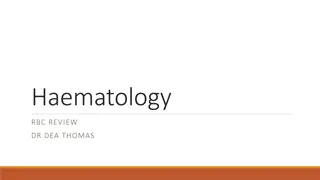Understanding Newborn Screening in Oklahoma
Newborn screening in Oklahoma is crucial for detecting hidden disorders in newborns that may not be apparent at birth. Early detection through screening can lead to timely treatment, ensuring healthy development and potentially saving lives. The process involves testing every newborn for harmful con
1 views • 88 slides
Patient Screening and Workflow Process Optimization
The flowcharts and descriptions detail the steps involved in identifying eligible patients for screening, managing patient flow during visits, and tracking screening results. The process includes reviewing patient charts, determining screening eligibility, discussing screening options with patients,
2 views • 5 slides
Understanding Lung Cancer Screening Programs and Criteria
Screening for lung cancer is essential for early detection and intervention. CT scans have shown promise in reducing mortality rates, especially in high-risk populations. While challenges like cost and radiation risk exist, initiatives like the National Lung Screening Trial have demonstrated the eff
4 views • 28 slides
Screening for Malnutrition with MUST Tool
Understanding malnutrition is crucial for maintaining optimal health. Screening with the Malnutrition Universal Screening Tool (MUST) is essential to identify individuals at risk. This tool involves assessing BMI, calculating weight loss scores, and determining overall malnutrition risk. Proper scre
5 views • 25 slides
Ensuring Equality of Access to Cervical Screening: Key Considerations
Providing guidance on promoting equality of access to cervical screening, the importance of informed choice, information accompanying screening invitations, and checking for understanding to support individuals making informed decisions. Emphasizes the need for culturally sensitive approaches, espec
5 views • 21 slides
Understanding Hemoglobin: Functions, Medical Applications, and Conditions
Hemoglobin, a crucial protein in red blood cells, plays a vital role in carrying oxygen throughout the body. This article delves into its functions, detection methods, medical applications, and common conditions associated with hemoglobin, such as anemia and polycythemia. Learn about the various typ
4 views • 16 slides
Overview of the NHS Cervical Screening Programme
The NHS Cervical Screening Programme aims to reduce the incidence and mortality of invasive cervical cancer by offering regular screening to eligible individuals. It covers the history, population screening programmes, and key milestones. Learn about the importance, coverage, and guidelines of the p
6 views • 19 slides
Addressing Anemia Among Pregnant Women in Meerut District
Anemia is a prevalent condition among pregnant women in Meerut, India. The Anemia Mukt Bharat program aims to reduce anemia rates by providing iron and folic acid supplements through ANC services. Data analysis shows progress in ANC registration and iron tablet consumption, highlighting the importan
0 views • 11 slides
Understanding Clinical Features of Anemia
Clinical features of anemia include cardiovascular adaptations, variations in symptom presentation based on speed and severity of onset, implications of age, and changes in the hemoglobin-O2 dissociation curve. Symptoms may range from breathlessness and weakness to cardiac issues, while signs like p
0 views • 28 slides
Understanding Red Blood Cell Abnormalities in Anemia: A Detailed Overview
This in-depth article delves into the various types of red blood cell abnormalities seen in anemia, such as anisocytosis, poikilocytosis, spherocytes, ovalocytes, acanthocytes, codocytes, drepanocytes, and stomatocytes. It explains the characteristics of each abnormality, their significance in diffe
0 views • 45 slides
Understanding Sanction Regime Framework and Screening Controls
The presented content illustrates the sanction regime framework and screening controls, highlighting the significance of sanctions, who should be screened, and what should be included in the screening process. It covers the scope of sanctions, the importance of sanction screening, tools used for scr
3 views • 42 slides
Comprehensive Guide to Screening and Prevention in Family Medicine
This comprehensive guide explores the definitions, uses, and levels of screening and prevention in family medicine. It covers the criteria for screening tests, types of screening, examples of targeted populations, and approaches to preventing common problems in primary care. The content discusses th
0 views • 73 slides
Understanding Packed Cell Volume (PCV) and Hematocrit in Blood Testing
Packed cell volume (PCV) is a measure of the percentage of blood volume occupied by red blood cells (RBCs), used to screen for anemia and calculate hemoglobin concentration. Also known as hematocrit (HCT), it falls within specific ranges for adult males and females. The PCV is determined from venous
0 views • 5 slides
Understanding Anemia: Causes, Mechanisms, and Classifications
Anemia is a condition characterized by a deficiency in red blood cells or their oxygen-carrying capacity, impacting physiological needs. Causes include blood loss, decreased production, and destruction of red blood cells. There are various classifications such as acute and chronic blood loss anemia,
0 views • 19 slides
Prostate Cancer Screening Guidelines in Canada: A Snapshot of Strategies
The Canadian Partnership Against Cancer annually collects and summarizes data on national, provincial, and territorial prostate cancer screening guidelines and strategies. Despite the absence of organized screening programs, some provinces have policies in place, with opportunistic screening by prim
0 views • 13 slides
Anemia in Swine: Causes, Clinical Signs, and Treatment
Anemia in swine can be caused by factors such as gastric ulcers, internal bleeding, and poor nutrition. Clinical signs include pale skin, rapid breathing, and jaundice. Piglet anemia, a highly fatal disease, is marked by decreased hemoglobin levels and liver degeneration. Diagnosis involves examinin
0 views • 11 slides
Iron Deficiency Anemia in a 78-Year-Old Man: A Case Study
A 78-year-old man presents with symptoms of fatigue, headache, and abdominal pain, leading to a diagnosis of iron deficiency anemia. His medical history includes hypertension, type II diabetes, and chronic shoulder pain. Investigations reveal hypochromic, microcytic anemia with low iron levels and h
0 views • 117 slides
Best Practices for Racial Equity Rapid Response Outreach
This document outlines suggested practices for a racial equity rapid response outreach program, focusing on a workflow for patient outreach, prioritizing patients based on specific criteria, and components of screening including wellness checks and screening for chronic medical conditions. The workf
0 views • 6 slides
Understanding Hemolytic Anemia: Classification and Management
Hemolytic anemia encompasses various subtypes like autoimmune hemolytic anemia, with warm and cold antibodies, each requiring unique management strategies. Diagnosis involves specific investigations like the Coombs test. Treatment typically involves corticosteroids as first-line therapy, while secon
1 views • 23 slides
Importance of Vision Screening for Young Children
Understanding the critical development of vision in young children is crucial, as vision conditions can go undetected but have significant impacts. Early screening helps in identifying refractive errors, amblyopia, and strabismus for successful treatment. Prevalence statistics highlight the importan
0 views • 23 slides
Understanding Anemia: Key Concepts and Clinical Features
Anemia is a common condition characterized by a reduction in hemoglobin levels, leading to decreased oxygen-carrying capacity in the blood. This article delves into important aspects such as hematopoiesis, erythropoiesis, hemoglobin synthesis, and clinical manifestations of anemia. Learn about the s
0 views • 18 slides
Understanding Anemia: Causes, Symptoms, and Classification
Anemia is characterized by a reduction in hemoglobin (Hg) concentration, hematocrit (Hct) concentration, or red blood cell (RBC) count. Common symptoms include fatigue, weakness, dizziness, and palpitations. Physical signs may include pallor and tachycardia. Pica, characterized by unusual cravings,
0 views • 23 slides
Newborn Screening Program Challenges in Africa
Newborn screening programs, particularly for diseases like sickle cell anemia, face challenges in adoption in African countries such as Nigeria despite their proven benefits. The Yoruba people, who dominate the southwestern part of Nigeria, have a significant population, and efforts are being made t
0 views • 11 slides
Implementing Pulse Oximetry Screening for CCHD in Indiana
Indiana implemented pulse oximetry screening for Critical Congenital Heart Disease (CCHD) for all newborns as mandated by state law. The legislation, effective from January 1, 2012, requires every newborn in Indiana to receive CCHD screening, with exceptions only for religious beliefs. The state wor
0 views • 13 slides
Understanding Sickle Cell Anemia: Causes, Symptoms, and Pathophysiology
Sickle cell anemia is an inherited disorder affecting red blood cells' shape, leading to decreased oxygen delivery and various symptoms like fatigue, pain episodes, and more. The condition arises from a genetic mutation affecting hemoglobin production. Individuals with sickle cell trait may not disp
0 views • 7 slides
Individualized Medicine and Biophysical System Dynamics in End-Stage Renal Disease
This presentation delves into the management of anemia in dialysis patients using system dynamics modeling, particularly at Mayo Clinic. Chronic kidney disease, hemodialysis, anemia, and the significance of erythropoietic stimulating agents are discussed. Anemia poses a key quality of life issue for
0 views • 26 slides
Enhancing Cervical Cancer Screening through NHS Cytology Programme
The NHS Cytology Screening Programme aims to reduce incidence and mortality from cervical cancer by offering systematic, efficient screening for pre-malignant diseases. With a history dating back to 1988, the programme targets women aged 25-64, emphasizing the importance of visualizing the cervix an
1 views • 38 slides
District Assessment Tool for Anemia (DATA) Overview
This presentation highlights the development and purpose of the District Assessment Tool for Anemia (DATA), emphasizing its role in addressing anemia as a multi-sectoral issue at the district level. The tool aims to assist stakeholders in identifying gaps, enablers, and barriers to tackling anemia r
0 views • 20 slides
Screening and Prevention in Family Practice
Definition of screening and prevention in family practice along with the Wilson-Jungner criteria, types of screening tests, and examples like colonoscopy and breast cancer screening. Objectives include understanding screening types and targeted populations, pros and cons of screening, and appropriat
0 views • 33 slides
Correlation Study of Low Birth Weight, Anemia, and Family Involvement in Antenatal Care
The study examines the relationship between family involvement in antenatal care, anemia, and low birth weight based on statistics from a Health Promoting Hospital in 2013. Analysis shows significant correlations between family involvement, anemia, and low birth weight, highlighting the importance o
0 views • 24 slides
Understanding G6PD Deficiency Hemolytic Anemia: Biochemical Basis and Implications
G6PD deficiency hemolytic anemia is an inherited condition characterized by reduced levels of glucose-6-phosphate dehydrogenase (G6PD), leading to impaired production of NADPH. This deficiency affects the Pentose Phosphate Pathway (PPP) and can result in oxidative stress, causing damage to DNA, prot
0 views • 18 slides
Understanding Anemia: Causes, Symptoms, and Diagnosis
Anemia is a condition characterized by low red blood cell count, leading to symptoms like fatigue, pale skin, and shortness of breath. Causes range from nutritional deficiencies to chronic diseases. Diagnosis involves blood tests and examination of red blood cells. This content delves into various t
0 views • 52 slides
Understanding Anemia: Causes, Types, and Impact on Indian Population
Anemia is a serious health condition characterized by low hemoglobin levels, leading to reduced oxygen supply to the body. This article delves into the definition of anemia, its types - including genetic and nutritional anemia, and highlights the significant prevalence of anemia in India, especially
0 views • 16 slides
Understanding Disease Screening and Prevention in Medicine
Explore the concepts of disease screening and prevention in preventive medicine. Learn about the importance of recognizing preclinical cases, the iceberg phenomenon of disease, and the role of medical intervention in arresting disease progression. Discover when to apply screening, the types of scree
0 views • 36 slides
Overview of Cervical Cancer Screening Programs in Canada
The Canadian Partnership Against Cancer conducts an annual environmental scan on cervical cancer screening guidelines and strategies across the country. Organized screening programs are available in most provinces, offering services to asymptomatic women at average risk. This scan provides insights
1 views • 46 slides
Anemia in Pregnancy: Types, Etiology, and Management
Dr. Methal A. Alrubaie, an assistant professor, presents a detailed overview of anemia in pregnancy. The content covers the classification of anemia types, their etiology, clinical presentation, effects on both mother and fetus, investigation methods, and treatment approaches. Various types of anemi
0 views • 19 slides
Understanding Anemia: Causes, Types, and Prevention
Anemia occurs when there are not enough red blood cells in the body, leading to symptoms like fatigue, rapid heartbeat, and pale skin. Causes include nutrient deficiencies, interfering substances, and poor environmental conditions. Different types of anemia such as hypochromic, megaloblastic, and di
0 views • 17 slides
Implementation of Flu-FIT Program for Patient Aligned Care Teams at East Orange VA
This study details the adaptation of the Flu-FIT Program to enhance colorectal cancer screening rates within patient aligned care teams at the Veterans Affairs (VA) Department. By linking influenza immunization with colorectal cancer screening using fecal immunochemical testing, the project aimed to
0 views • 10 slides
Impact of COVID-19 on Cancer Screening Rates in Primary Care
This study examines the impact of the COVID-19 pandemic on colorectal, breast, and cervical cancer screening rates in safety-net primary care practices. A 7-year Quality Improvement Project aimed to increase screening rates through tailored education and practice facilitation. The project faced chal
0 views • 5 slides
Sickle cell Anemia treatment in India for African Children
Sickle Cell Treatment in India for African Children\nSickle Cell Anemia or Sickle Cell Disease is very common in Sub-Saharan African countries. The demographic prevalence of Sickle cell anemia can be gauged from the following acknowledged numbers of
1 views • 3 slides







































